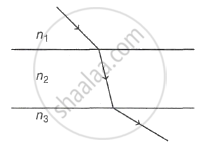Advertisements
Advertisements
प्रश्न
Answer the following question.
Why is photolysis of water accompanied with non-cyclic photophosphorylation?
उत्तर
- Photolysis of water provides new electrons to Photosystem – II.
- The water molecule is lysed into three components:
a. Protons (H+) which are used as part of reactions that make NADPH.
b. The Second component formed is electrons which replaces the electrons lost by PS-II.
c. The third component is oxygen (O2) which is released into the atmosphere. - Photosystem I sends electrons to reduce NADP+.
- Then, Photosystem II sends replacement electrons to Photosystem I.
- Finally, the photolysis of water replaces the electrons lost by Photosystem II.
- Water is the ultimate source of electrons for photosynthesis.
Therefore, the photolysis of water is accompanied by non – cyclic photophosphorylation.
APPEARS IN
संबंधित प्रश्न
A concave mirror of curvature 40 cm, used for shaving purposes produces image of double size as that of the object. Object distance must be ______.
Answer the following question.
As per recent development, what is the nature of light? Wave optics and particle nature of light are used to explain which phenomena of light respectively?
Distinguish between action spectrum and absorption spectrum.
Light of wavelength 5000 A.U. falls on a plane reflecting surface. The frequency of reflected light is ______
In Young’s double-slit experiment, if there is no initial phase difference between the light from the two slits, a point on the screen corresponds to the 5th minimum. What is the path difference?
Which of the following is not a property of light?
A ray of light is incident at an angle ion one face of prism of small angle A and emerges normally from the other surface. µ is the refractive index of the material of the prism. The angle of incidence is _____________.
When light enters glass from vacuum then the wavelength of light ______
The critical angle for light travelling from medium P to medium Q is 'θ'. The speed of light in medium P is 'v'. Then the speed of light in medium Q is ______.
A beam of light passes from medium 1 to medium 2 to medium 3 as shown in the diagram. What may be concluded about the three refractive indices n1, n2 and n3?

